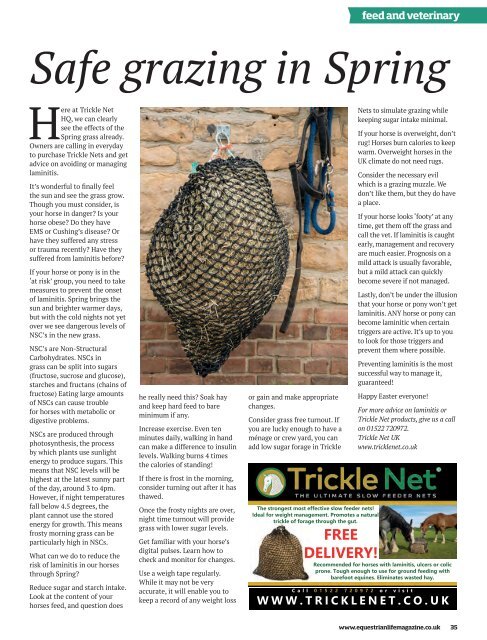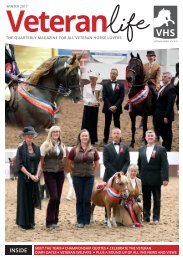Equestrian Life April 2018 Issue
Your leading monthly magazine for all horse lovers and riders
Your leading monthly magazine for all horse lovers and riders
Create successful ePaper yourself
Turn your PDF publications into a flip-book with our unique Google optimized e-Paper software.
feed and veterinary<br />
Safe grazing in Spring<br />
Here at Trickle Net<br />
HQ, we can clearly<br />
see the effects of the<br />
Spring grass already.<br />
Owners are calling in everyday<br />
to purchase Trickle Nets and get<br />
advice on avoiding or managing<br />
laminitis.<br />
It’s wonderful to finally feel<br />
the sun and see the grass grow.<br />
Though you must consider, is<br />
your horse in danger? Is your<br />
horse obese? Do they have<br />
EMS or Cushing’s disease? Or<br />
have they suffered any stress<br />
or trauma recently? Have they<br />
suffered from laminitis before?<br />
If your horse or pony is in the<br />
‘at risk’ group, you need to take<br />
measures to prevent the onset<br />
of laminitis. Spring brings the<br />
sun and brighter warmer days,<br />
but with the cold nights not yet<br />
over we see dangerous levels of<br />
NSC’s in the new grass.<br />
NSC’s are Non-Structural<br />
Carbohydrates. NSCs in<br />
grass can be split into sugars<br />
(fructose, sucrose and glucose),<br />
starches and fructans (chains of<br />
fructose) Eating large amounts<br />
of NSCs can cause trouble<br />
for horses with metabolic or<br />
digestive problems.<br />
NSCs are produced through<br />
photosynthesis, the process<br />
by which plants use sunlight<br />
energy to produce sugars. This<br />
means that NSC levels will be<br />
highest at the latest sunny part<br />
of the day, around 3 to 4pm.<br />
However, if night temperatures<br />
fall below 4.5 degrees, the<br />
plant cannot use the stored<br />
energy for growth. This means<br />
frosty morning grass can be<br />
particularly high in NSCs.<br />
What can we do to reduce the<br />
risk of laminitis in our horses<br />
through Spring?<br />
Reduce sugar and starch intake.<br />
Look at the content of your<br />
horses feed, and question does<br />
he really need this? Soak hay<br />
and keep hard feed to bare<br />
minimum if any.<br />
Increase exercise. Even ten<br />
minutes daily, walking in hand<br />
can make a difference to insulin<br />
levels. Walking burns 4 times<br />
the calories of standing!<br />
If there is frost in the morning,<br />
consider turning out after it has<br />
thawed.<br />
Once the frosty nights are over,<br />
night time turnout will provide<br />
grass with lower sugar levels.<br />
Get familiar with your horse’s<br />
digital pulses. Learn how to<br />
check and monitor for changes.<br />
Use a weigh tape regularly.<br />
While it may not be very<br />
accurate, it will enable you to<br />
keep a record of any weight loss<br />
or gain and make appropriate<br />
changes.<br />
Consider grass free turnout. If<br />
you are lucky enough to have a<br />
ménage or crew yard, you can<br />
add low sugar forage in Trickle<br />
Nets to simulate grazing while<br />
keeping sugar intake minimal.<br />
If your horse is overweight, don’t<br />
rug! Horses burn calories to keep<br />
warm. Overweight horses in the<br />
UK climate do not need rugs.<br />
Consider the necessary evil<br />
which is a grazing muzzle. We<br />
don’t like them, but they do have<br />
a place.<br />
If your horse looks ‘footy’ at any<br />
time, get them off the grass and<br />
call the vet. If laminitis is caught<br />
early, management and recovery<br />
are much easier. Prognosis on a<br />
mild attack is usually favorable,<br />
but a mild attack can quickly<br />
become severe if not managed.<br />
Lastly, don’t be under the illusion<br />
that your horse or pony won’t get<br />
laminitis. ANY horse or pony can<br />
become laminitic when certain<br />
triggers are active. It’s up to you<br />
to look for those triggers and<br />
prevent them where possible.<br />
Preventing laminitis is the most<br />
successful way to manage it,<br />
guaranteed!<br />
Happy Easter everyone!<br />
For more advice on laminitis or<br />
Trickle Net products, give us a call<br />
on 01522 720972.<br />
Trickle Net UK<br />
www.tricklenet.co.uk<br />
The strongest most effective slow feeder nets!<br />
Ideal for weight management. Promotes a natural<br />
trickle of forage through the gut.<br />
FREE<br />
DELIVERY!<br />
Recommended for horses with laminitis, ulcers or colic<br />
prone. Tough enough to use for ground feeding with<br />
barefoot equines. Eliminates wasted hay.<br />
Call 01522 720972 or visit<br />
WWW.TRICKLENET.CO.UK<br />
www.equestrianlifemagazine.co.uk 35
















